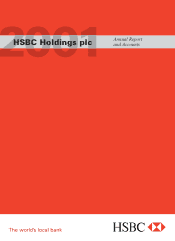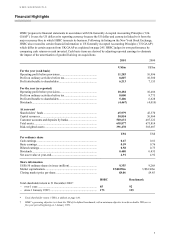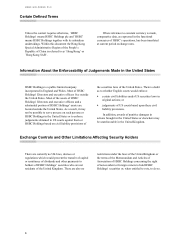HSBC 2001 Annual Report Download - page 9
Download and view the complete annual report
Please find page 9 of the 2001 HSBC annual report below. You can navigate through the pages in the report by either clicking on the pages listed below, or by using the keyword search tool below to find specific information within the annual report.
HSBC HOLDINGS PLC
Description of Business
7
Introduction
HSBC is one of the largest banking and financial
services organisations in the world, with a market
capitalisation of US$109 billion at 31 December
2001. At the end of 2001, HSBC had total assets of
US$696 billion and shareholders’ equity of US$46
billion. For the year ended 31 December 2001,
HSBC’s operating profit was US$7 billion on
revenues of US$26 billion. HSBC is a strongly
capitalised banking group with a total capital ratio of
13.0 per cent and a tier 1 capital ratio of 9.0 per cent
as at 31 December 2001.
Headquartered in London, HSBC operates
through long-established businesses in five regions:
Europe; Hong Kong; rest of Asia-Pacific, including
the Middle East and Africa; North America; and
Latin America. Within each of these geographical
regions, the principal businesses operate essentially
as domestic banks and typically have a large retail
deposit base, together with strong liquidity and
capital ratios, and provide services to personal,
commercial and large corporate and institutional
customers. By using HSBC’s highly efficient
technological links, all businesses are able to access
HSBC’s wide range of products and services and
adapt them to local customer needs. In addition, in
certain key locations – London, Hong Kong, New
York, Geneva, Paris and Düsseldorf – HSBC has
significant investment and private banking
operations which, together with its commercial
banks, enable HSBC to service the full range of
requirements of its high net worth personal and large
corporate and institutional customers.
Through its global network of some 7,000
offices in 81 countries and territories, HSBC
provides a comprehensive range of financial services
to personal, commercial, corporate, institutional and
investment and private banking clients. As part of its
strategy, HSBC created a global brand in 1998, using
HSBC and its hexagon symbol in most of its areas of
operation.
HSBC’s largest and best-known subsidiaries and
their primary areas of operation are:
• The Hongkong and
Shanghai Banking
Corporation Limited
Hong Kong SAR, with
an extensive network
throughout Asia-
Pacific.
• Hang Seng Bank
Limited (‘Hang Seng
Bank’ )
Hong Kong SAR
• HSBC Bank plc United Kingdom
• Crédit Commercial
de France (‘CCF’ )
France
• HSBC Bank USA New York State in the
United States
• HSBC Bank Brasil
S.A.-Banco Múltiplo
(‘HSBC Bank
Brasil’ )
Brazil
• HSBC Private
Banking Holdings
(Suisse) S.A.
(‘HSBC Republic
Suisse’ )
Switzerland, France,
Luxembourg, Guernsey
and Monaco (through
various subsidiaries)
Management and resources
HSBC recognises that the substantial customer and
asset base of its banking operations reflects years of
trust and goodwill. Through its many years of
operation, HSBC has developed a reputation for
placing great value on long-term relationships with
its clients, and of observing the principles of sound
and conservative banking. HSBC organises and
delivers its banking products and services in a way
that aims to retain local authority while capitalising
on the advantages that flow from being an
international organisation.
HSBC believes that this combination of
centralisation and local responsibility permits it to
remain responsive to local needs while providing
customers with access to the services and strength of
a worldwide financial institution.
HSBC allocates resources, including capital,
management time, human resources and information
technology, according to a range of factors, such as
size and complexity of the operation, growth
prospects and the contribution made by each area.
Economic profit is used by HSBC’s management to
decide where to allocate resources so that they will
be most productive.






















